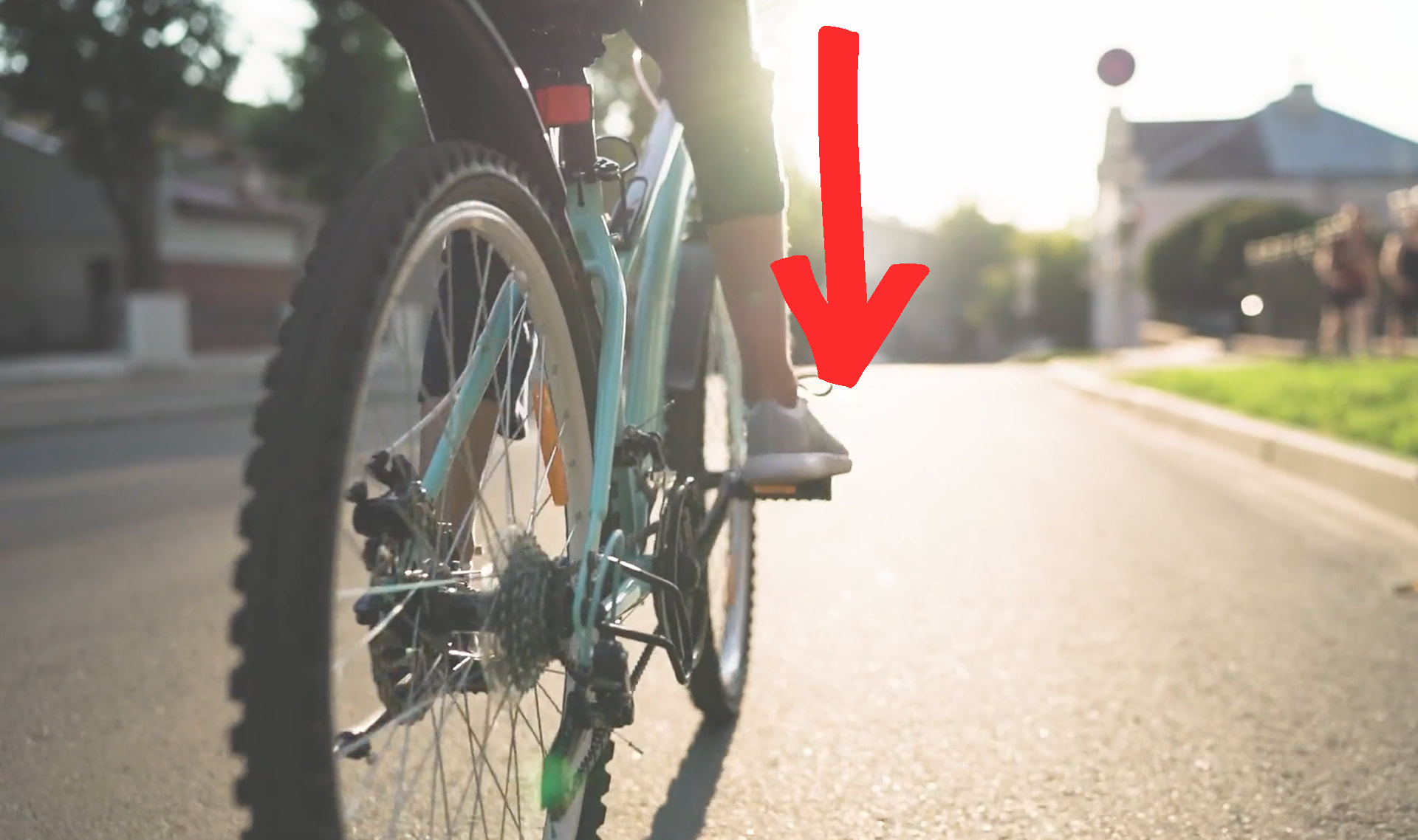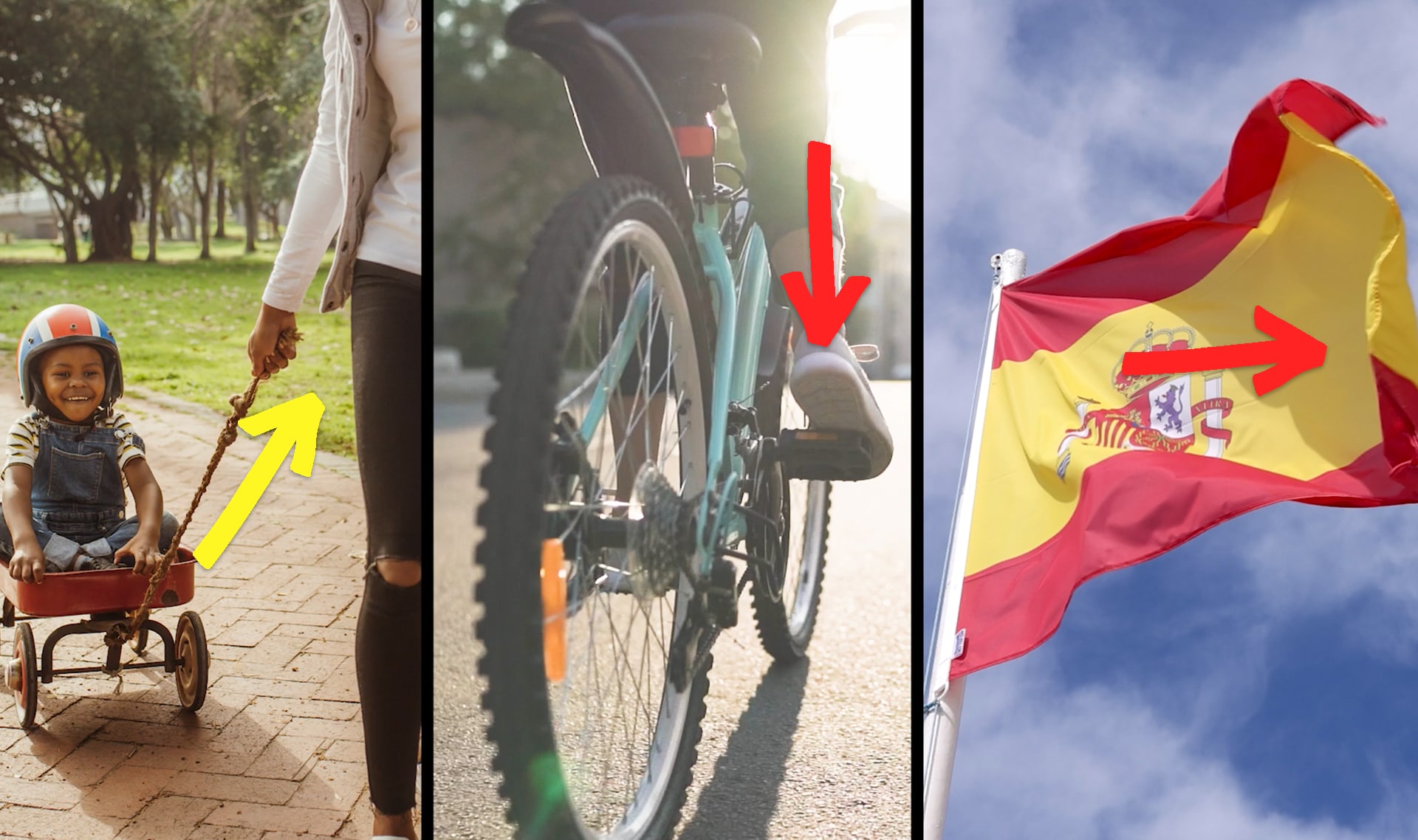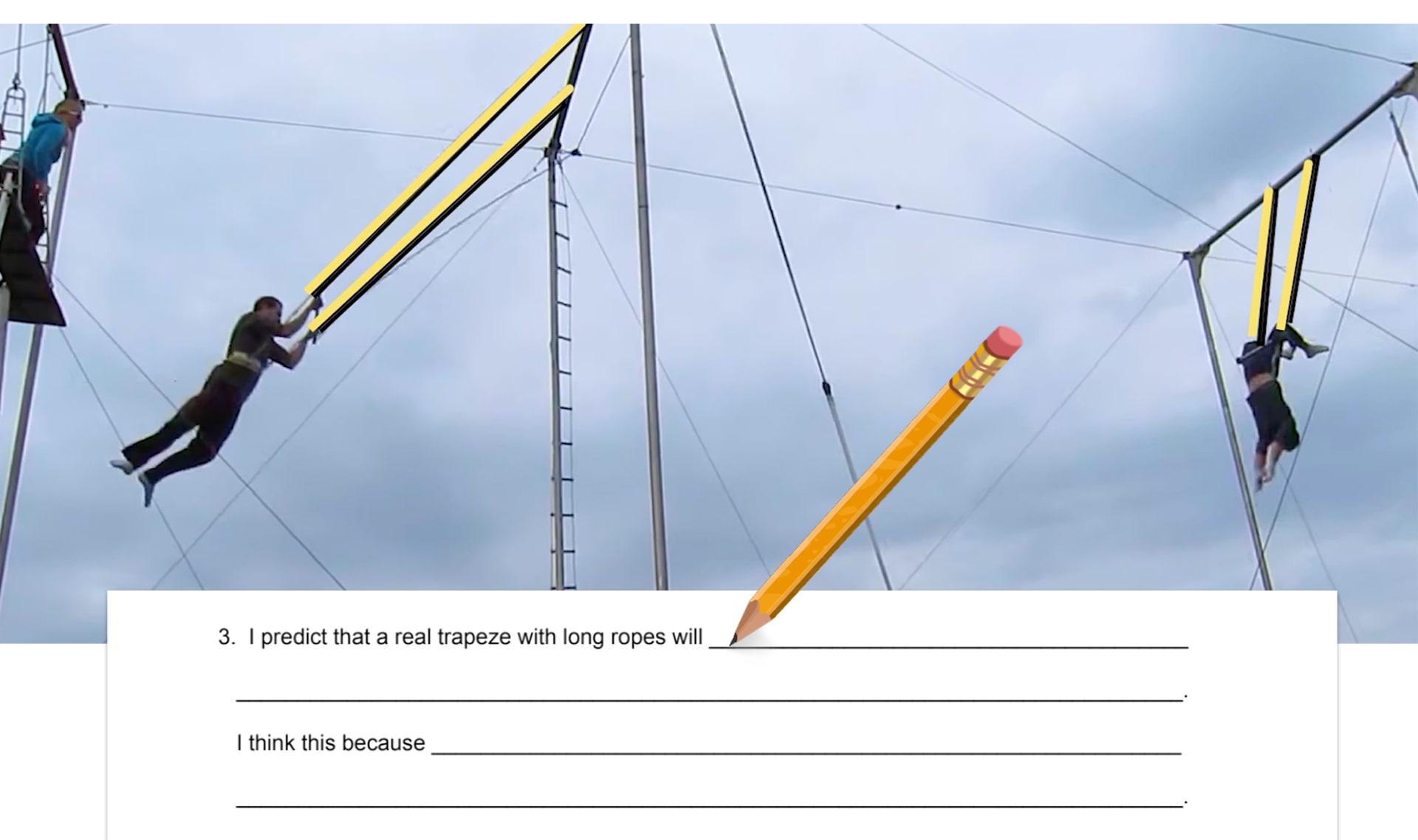
How high can you swing on a flying trapeze?
Scroll for prep

Please wait…
This video is having trouble loading. You may have lost your Internet connection.
Step 1: Click to Reload this page
Step 2: Click to
Try our other video player
Step 3: contact support if trouble persists.
Or,
dismiss this message.

Please wait…
This video is having trouble loading. You may have lost your Internet connection.
Step 1: Click to Reload this page
Step 2: Click to
Try our other video player
Step 3: contact support if trouble persists.
Or,
dismiss this message.
DISCUSS:
How are these two things SIMILAR? How are they DIFFERENT?
How are these two things SIMILAR? How are they DIFFERENT?

Please wait…
This video is having trouble loading. You may have lost your Internet connection.
Step 1: Click to Reload this page
Step 2: Click to
Try our other video player
Step 3: contact support if trouble persists.
Or,
dismiss this message.
DISCUSS:
How did you know where the swing was going to swing next?

Please wait…
This video is having trouble loading. You may have lost your Internet connection.
Step 1: Click to Reload this page
Step 2: Click to
Try our other video player
Step 3: contact support if trouble persists.
Or,
dismiss this message.
DISCUSS:
How can you figure out how a trapeze artist will swing in different situations, without practicing on a real trapeze?

Please wait…
This video is having trouble loading. You may have lost your Internet connection.
Step 1: Click to Reload this page
Step 2: Click to
Try our other video player
Step 3: contact support if trouble persists.
Or,
dismiss this message.

Please wait…
This video is having trouble loading. You may have lost your Internet connection.
Step 1: Click to Reload this page
Step 2: Click to
Try our other video player
Step 3: contact support if trouble persists.
Or,
dismiss this message.
Step
01/21
01/21
You’ll work with a partner.
Decide who will be Acrobat and who will be Performer.
Decide who will be Acrobat and who will be Performer.

Please wait…
This video is having trouble loading. You may have lost your Internet connection.
Step 1: Click to Reload this page
Step 2: Click to
Try our other video player
Step 3: contact support if trouble persists.
Or,
dismiss this message.
Step
02/21
02/21
Get your supplies.

Please wait…
This video is having trouble loading. You may have lost your Internet connection.
Step 1: Click to Reload this page
Step 2: Click to
Try our other video player
Step 3: contact support if trouble persists.
Or,
dismiss this message.
Step
03/21
03/21
Acrobat: Lay the ruler on your desk.
Performer: Place a pencil at each end of the ruler with the erasers
facing toward you.
Performer: Place a pencil at each end of the ruler with the erasers
facing toward you.

Please wait…
This video is having trouble loading. You may have lost your Internet connection.
Step 1: Click to Reload this page
Step 2: Click to
Try our other video player
Step 3: contact support if trouble persists.
Or,
dismiss this message.
Step
04/21
04/21
Acrobat: Pull one pencil so that it is hanging off the desk a bit.
Performer: Add one sticker to the end of the pencil. Add another
sticker near the edge of the desk. Add a heavy book.
Performer: Add one sticker to the end of the pencil. Add another
sticker near the edge of the desk. Add a heavy book.

Please wait…
This video is having trouble loading. You may have lost your Internet connection.
Step 1: Click to Reload this page
Step 2: Click to
Try our other video player
Step 3: contact support if trouble persists.
Or,
dismiss this message.
Step
05/21
05/21
Both: Get one piece of string and one of the binder clips. Push the
string through the loops of the binder clip. Hold it up so it looks like a
swing.
string through the loops of the binder clip. Hold it up so it looks like a
swing.

Please wait…
This video is having trouble loading. You may have lost your Internet connection.
Step 1: Click to Reload this page
Step 2: Click to
Try our other video player
Step 3: contact support if trouble persists.
Or,
dismiss this message.
Step
06/21
06/21
Acrobat: Drape the string ends over one of the pencils, leaving space
between the two string ends. Performer: Get another binder clip
and clip it over the string and the pencil.
between the two string ends. Performer: Get another binder clip
and clip it over the string and the pencil.

Please wait…
This video is having trouble loading. You may have lost your Internet connection.
Step 1: Click to Reload this page
Step 2: Click to
Try our other video player
Step 3: contact support if trouble persists.
Or,
dismiss this message.
Step
07/21
07/21
Both: Add one penny to the binder clip at the bottom of each
trapeze.
trapeze.

Please wait…
This video is having trouble loading. You may have lost your Internet connection.
Step 1: Click to Reload this page
Step 2: Click to
Try our other video player
Step 3: contact support if trouble persists.
Or,
dismiss this message.
Step
08/21
08/21
Take a seat on the floor so that you can observe your model trapeze
more clearly. Check to make sure your trapeze model looks just like
ours.
more clearly. Check to make sure your trapeze model looks just like
ours.

Please wait…
This video is having trouble loading. You may have lost your Internet connection.
Step 1: Click to Reload this page
Step 2: Click to
Try our other video player
Step 3: contact support if trouble persists.
Or,
dismiss this message.
Step
09/21
09/21
Both: Practice gently releasing your model trapeze.

Please wait…
This video is having trouble loading. You may have lost your Internet connection.
Step 1: Click to Reload this page
Step 2: Click to
Try our other video player
Step 3: contact support if trouble persists.
Or,
dismiss this message.
Step
10/21
10/21
Experiment #1: Height. Try releasing the trapeze from different
heights. Try at least one high release and one low release. What do
you notice about how high it reaches on the other side?
heights. Try at least one high release and one low release. What do
you notice about how high it reaches on the other side?

Please wait…
This video is having trouble loading. You may have lost your Internet connection.
Step 1: Click to Reload this page
Step 2: Click to
Try our other video player
Step 3: contact support if trouble persists.
Or,
dismiss this message.
Step
11a/21
11a/21
Discuss.

Please wait…
This video is having trouble loading. You may have lost your Internet connection.
Step 1: Click to Reload this page
Step 2: Click to
Try our other video player
Step 3: contact support if trouble persists.
Or,
dismiss this message.
Step
11b/21
11b/21
Here’s what we noticed.

Please wait…
This video is having trouble loading. You may have lost your Internet connection.
Step 1: Click to Reload this page
Step 2: Click to
Try our other video player
Step 3: contact support if trouble persists.
Or,
dismiss this message.
Step
12/21
12/21
Experiment #2: Length of String. Does the length of the string
change how the trapeze moves? Work with your partner to make the
string of one trapeze about half the length of the other trapeze.
change how the trapeze moves? Work with your partner to make the
string of one trapeze about half the length of the other trapeze.

Please wait…
This video is having trouble loading. You may have lost your Internet connection.
Step 1: Click to Reload this page
Step 2: Click to
Try our other video player
Step 3: contact support if trouble persists.
Or,
dismiss this message.
Step
13a/21
13a/21
Both: Make observations of your two trapezes. Watch carefully for
any differences or similarities in how they move.
any differences or similarities in how they move.

Please wait…
This video is having trouble loading. You may have lost your Internet connection.
Step 1: Click to Reload this page
Step 2: Click to
Try our other video player
Step 3: contact support if trouble persists.
Or,
dismiss this message.
Step
13b/21
13b/21
Let’s try using a timer to help us count and measure how fast each
trapeze is moving. When I say “Start,” count the number of swings
that you see in this animation until I say “Stop.”
trapeze is moving. When I say “Start,” count the number of swings
that you see in this animation until I say “Stop.”

Please wait…
This video is having trouble loading. You may have lost your Internet connection.
Step 1: Click to Reload this page
Step 2: Click to
Try our other video player
Step 3: contact support if trouble persists.
Or,
dismiss this message.
Step
14/21
14/21
Count how many times the trapeze with the long string swings
in 10 seconds. Record that number on your worksheet.
in 10 seconds. Record that number on your worksheet.

Please wait…
This video is having trouble loading. You may have lost your Internet connection.
Step 1: Click to Reload this page
Step 2: Click to
Try our other video player
Step 3: contact support if trouble persists.
Or,
dismiss this message.
Step
15/21
15/21
Count how many times the trapeze with the short string swings
in 10 seconds. Record that number on your worksheet.
in 10 seconds. Record that number on your worksheet.

Please wait…
This video is having trouble loading. You may have lost your Internet connection.
Step 1: Click to Reload this page
Step 2: Click to
Try our other video player
Step 3: contact support if trouble persists.
Or,
dismiss this message.
Step
16a/21
16a/21
Discuss and make a prediction with your partner.
Answer Question #3 on your worksheet.
Answer Question #3 on your worksheet.

Please wait…
This video is having trouble loading. You may have lost your Internet connection.
Step 1: Click to Reload this page
Step 2: Click to
Try our other video player
Step 3: contact support if trouble persists.
Or,
dismiss this message.
Step
16b/21
16b/21
Here’s what we noticed.

Please wait…
This video is having trouble loading. You may have lost your Internet connection.
Step 1: Click to Reload this page
Step 2: Click to
Try our other video player
Step 3: contact support if trouble persists.
Or,
dismiss this message.
Step
17/21
17/21
Experiment #3: Number of People (or Pennies). Does the number of
pennies change how the trapeze moves? Decide with your partner
two numbers of pennies that you will compare to one another.
pennies change how the trapeze moves? Decide with your partner
two numbers of pennies that you will compare to one another.

Please wait…
This video is having trouble loading. You may have lost your Internet connection.
Step 1: Click to Reload this page
Step 2: Click to
Try our other video player
Step 3: contact support if trouble persists.
Or,
dismiss this message.
Step
18/21
18/21
Add the number of pennies that you decided to test first to your
binder clip. Count the number of swings that you see in 10 seconds.
binder clip. Count the number of swings that you see in 10 seconds.

Please wait…
This video is having trouble loading. You may have lost your Internet connection.
Step 1: Click to Reload this page
Step 2: Click to
Try our other video player
Step 3: contact support if trouble persists.
Or,
dismiss this message.
Step
19/21
19/21
Adjust the number of pennies in the binder clip of your trapeze.
Count the number of swings that you see in 10 seconds.
Count the number of swings that you see in 10 seconds.

Please wait…
This video is having trouble loading. You may have lost your Internet connection.
Step 1: Click to Reload this page
Step 2: Click to
Try our other video player
Step 3: contact support if trouble persists.
Or,
dismiss this message.
Step
20a/21
20a/21
Discuss and make a prediction with your partner.
Answer Question #6 on your worksheet.
Answer Question #6 on your worksheet.

Please wait…
This video is having trouble loading. You may have lost your Internet connection.
Step 1: Click to Reload this page
Step 2: Click to
Try our other video player
Step 3: contact support if trouble persists.
Or,
dismiss this message.
Step
20b/21
20b/21
Here’s what we noticed.

Please wait…
This video is having trouble loading. You may have lost your Internet connection.
Step 1: Click to Reload this page
Step 2: Click to
Try our other video player
Step 3: contact support if trouble persists.
Or,
dismiss this message.
Step
21/21
21/21
Work with your partner to clean up. Then, go ahead and take a seat.
Discuss.
Discuss.

Please wait…
This video is having trouble loading. You may have lost your Internet connection.
Step 1: Click to Reload this page
Step 2: Click to
Try our other video player
Step 3: contact support if trouble persists.
Or,
dismiss this message.
DISCUSS:
What force do you think made your tiny trapeze start swinging when you let go?

Please wait…
This video is having trouble loading. You may have lost your Internet connection.
Step 1: Click to Reload this page
Step 2: Click to
Try our other video player
Step 3: contact support if trouble persists.
Or,
dismiss this message.

Please wait…
This video is having trouble loading. You may have lost your Internet connection.
Step 1: Click to Reload this page
Step 2: Click to
Try our other video player
Step 3: contact support if trouble persists.
Or,
dismiss this message.
DISCUSS:
What do you think could be making this swing slow down and stop?
What do you think could be making this swing slow down and stop?

Please wait…
This video is having trouble loading. You may have lost your Internet connection.
Step 1: Click to Reload this page
Step 2: Click to
Try our other video player
Step 3: contact support if trouble persists.
Or,
dismiss this message.


push
1 of 9
to move an object away from you

pull
2 of 9
to move an object toward you

force
3 of 9
a push or a pull

Please wait…
This video is having trouble loading. You may have lost your Internet connection.
Step 1: Click to Reload this page
Step 2: Click to
Try our other video player
Step 3: contact support if trouble persists.
Or,
dismiss this message.
motion
4 of 9
a change in the position of an object

Please wait…
This video is having trouble loading. You may have lost your Internet connection.
Step 1: Click to Reload this page
Step 2: Click to
Try our other video player
Step 3: contact support if trouble persists.
Or,
dismiss this message.
gravity
5 of 9
an invisible force that pulls any object down, toward the Earth

Please wait…
This video is having trouble loading. You may have lost your Internet connection.
Step 1: Click to Reload this page
Step 2: Click to
Try our other video player
Step 3: contact support if trouble persists.
Or,
dismiss this message.
friction
6 of 9
an invisible force that resists the motion of an object

predict
7 of 9
to guess what will happen based on things you know

Please wait…
This video is having trouble loading. You may have lost your Internet connection.
Step 1: Click to Reload this page
Step 2: Click to
Try our other video player
Step 3: contact support if trouble persists.
Or,
dismiss this message.
pattern
8 of 9
something that happens again and again and again in a way that can be predicted

Please wait…
This video is having trouble loading. You may have lost your Internet connection.
Step 1: Click to Reload this page
Step 2: Click to
Try our other video player
Step 3: contact support if trouble persists.
Or,
dismiss this message.
model
9 of 9
a pretend version of something that scientists use when the real thing is too big, small, or complicated to work with
🎉
That’s it for this lesson! How did it go?
Extend this lesson
Sign up now for more great lessons!


